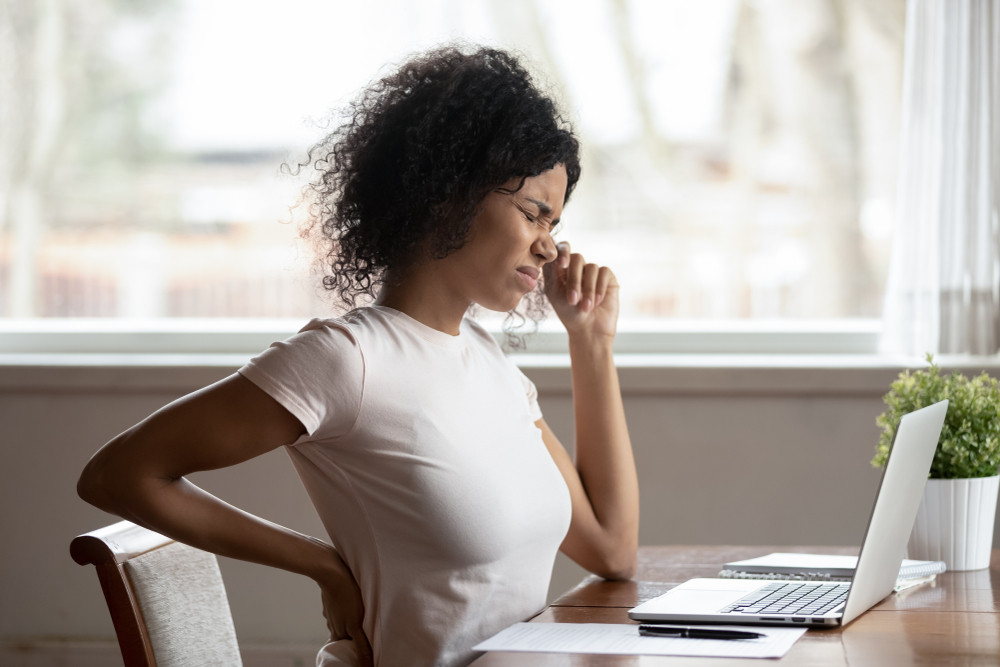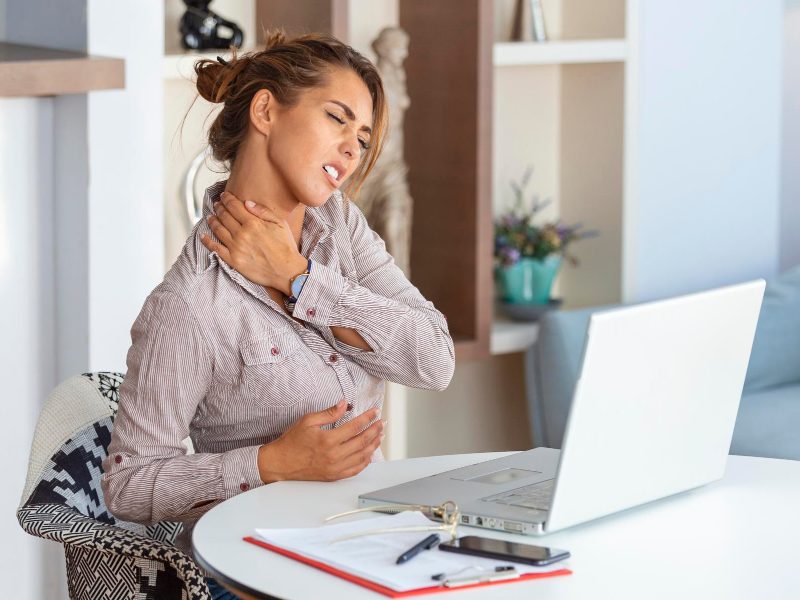
Article by Nichola Adams
It can also cause many mental health issues, such as stress, anxiety and depression. A study conducted by General Hospital Psychiatry looked at the links between back pain and psychological illness in low, middle-income countries where it’s prevalent. It was revealed that people with back pain (compared to people without it) were more than twice as likely to experience depression, psychosis, stress, anxiety and sleep deprivation.
Saint Teresa of Avila once said: ‘Treat your body so well that your soul is thrilled to live in it.’ Using a holistic ergonomic approach to keeping your back and the rest of your body healthy by paying attention to your posture, eating well, moving well and reducing stress levels can significantly affect your pain levels. This in turn then improves your overall wellbeing.
It can take as little as two weeks for a body to reverse the damage to repetitive stressors if addressed early on. By moving more, correcting how you stand, improving sitting posture, addressing stress levels and combining regular aerobic and resistance exercises, it’s possible for back health to massively improve. As we spend most of our day working, here are nine ways to ensure your back is healthy at home, or in the office.
Backs are healthiest when we are either sitting in upright postures or moving. This is because slouching puts pressure on the discs and creates tension build-up in our muscles and tissues, which, over time, can create a pain response. The aim is to understand what causes you to slouch or adopt poor postures.
The number one reason for the huge increase in back pain recently was the move to home working. Laptop usage, for hours at a time, can cause neck strain, headaches, shoulder pain and lower back pain. Why? Because it compromises our posture. The single, most effective thing that you can do is to raise the laptop to eye level but then use a separate keyboard and mouse so you can comfortably sit up straight whilst keeping your arms by your side.
Another key factor to address is height. Sitting height: the first thing to check when you sit down to work is whether your elbows are level with the top of the desk. By sitting at a height that allows your hands to float above the keyboard, with your wrists straight, you can relax those shoulders and wrists, preventing pain and tension from building up. Screen height: ensure the top of your screen is around eye height to subconsciously remind you to sit up straight with your head relaxed, and this reduces the tendency to slowly slouch forward to read the screen. In addition, ensure it is straight in front of you to avoid twisting your head or body to use it.
A really common issue is pins and needles or numbness in the wrists, often with referred pain travelling up the arm. A simple way to prevent this is to avoid resting the wrists on the table or keyboard when you are typing. Bring the keyboard and mouse close to the front of the desk, and instantly you can sit back, with your arms resting by your side, in a relaxed upright position and the wrists able to hover comfortably above the keyboard, promoting freedom of mind and movement!
It is essential if you are working long hours on a chair and have a sensitised back to sit back in your chair and allow the backrest to support you, signalling to the back muscles that they can relax. It is important to have support in the lower back curve as this promotes an upright S shape for our spine.
Choosing the right chair for you is complex. Having one with as many adjustable features as possible can be beneficial. Look for one with height-adjustable armrests, an adjustable seat height and depth that fits your thigh length, height and depth-adjustable lumbar support, and preferably a backrest that adjusts in angle.
When you sit all day and don’t move, you might feel a bit sore and stiff due to the fluid being forced out of your tissues, your pH level dropping, and your tissues becoming more acidic and dry. This excites the sensors in the tissue, sending dangerous messages to the brain, and creating that pain response. ‘Motion is Lotion’ (Lorimer Moseley): you need to keep your muscles and tissues healthy by moving. There is a lot of research about when to move, but listen to your body: if you know you start to feel discomfort after 30 minutes of sitting, ensure you start to create a habit of moving every 25 minutes. At the very least, try not to stay sitting for more than an hour at a time.
Eating antioxidant-rich foods has been proven to help our bodies heal. Eating unprocessed food with high vitamin content helps in the fight against back pain, aiding healthy nerve and muscle function. Check with your doctor or nutritionist that your vitamin levels and diet are optimal. Staying hydrated is also key.
Whilst we can address any structural issues or physical stressors, it is important to acknowledge the impact of emotions on our bodies. Physical pain is easier to feel than emotional pain. The first thing we do when stressed is tense our muscles in preparation for a subconscious fight or flight response. We also tend to breathe more shallowly, further reducing the oxygen in our system. So, the next time you feel stressed, try to pause for a few seconds and breathe.
Nichola Adams, MSc Health Ergonomics, Tech CIEHF, is the Founder of Inspired Ergonomics, specialising in providing highly effective solutions to reduce and prevent back pain in the workplace, having also trained in the Biopsychosocial approach to chronic pain. Nichola has been providing consultancy services since 2006 and has designed her own specialist back care office chair (Corrigo Design) made here in the UK.
Further reads below
Inspired Ergonomics | WATC Health & Welling

Nichola Adams, MSc Health Ergonomics, Tech CIEHF, is the Founder of Inspired Ergonomics, specialising in providing highly effective solutions to reduce and prevent back pain in the workplace, having also trained in the Biopsychosocial approach to chronic pain. Nichola has been providing consultancy services since 2006 and has designed her own specialist back care office chair (Corrigo Design) made here in the UK.

